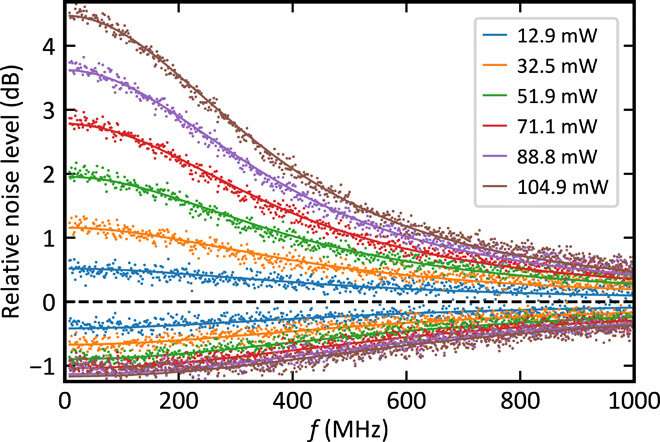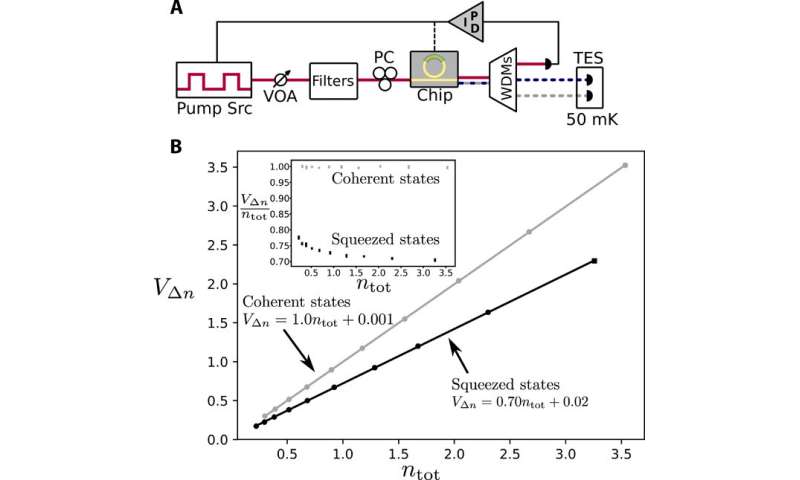
Scientists can generate squeezed light via strongly driven spontaneous four-wave mixing below threshold in silicon nitride microring resonators. The generated light can be characterized with homodyne detection (to extract phase- or frequency-encoded information) and through direct measurements of photon statistics. In a new report now published on Science Advances, V.D. Vaidya, and a team of scientists in Canada and the U.S. measured the quadrature-squeezed vacuum and photon number difference generated within an integrated nanophotonic device. The results will impact applications in quantum technology.
The concept of squeezed light is relevant in quantum optical processing, where the associated architectures of continuous variable photonics demand high-quality, scalable devices to generate squeezed light for many fundamental photonic quantum information processing applications. Examples include continuous variable (CV) quantum computation and Gaussian boson sampling, which is a promising avenue to achieve near-thermal quantum advantage and accommodate a range of intriguing concepts, including molecular vibronic spectrum simulations, graph isomorphism, perfect matchings and graph similarity.
Squeezed light for quantum optical processing
Most of these quantum applications require a scalable source of squeezed light to implement and enhance optical sensing near the quantum limit. Integrated photonics is a natural platform to explore these scalable squeezed light sources, where the stability and high-throughput manufacturability offered by modern lithographic (patterning) methods present promising pathways to realize useful quantum technologies at scale. However, progress to date on chip-integrated squeezing is limited. In the present study, therefore, Vaidya et al. used spontaneous four-wave mixing (SWFM) in silicon nitride microring resonators to provide a readily accessible and mature technology on commercial fabrication platforms.

The experimental device itself had simple dimensions, where both quadrature and photon number difference squeezing could be generated in silicon nitride (Si3N4) microring resonators, point coupled to channel waveguides. The setup also included microheaters overlaid for resonance wavelength tuning and stabilization. The scientists used a commercial foundry for fabrication where the waveguide contained silicon nitride fully clad in silicon dioxide (SiO2). The team used SWFM to generate squeezing and form a pair of signal and idler photons. The experimental setup allowed significant quadrature squeezing at modest input power levels. The team measured the quadrature and photon number statistics from the device and compared the results with theoretical predictions.
Quadrature squeezing - the experiment
The team characterized the quantum state of the resonator output as a two-mode squeezed vacuum state subjected to loss, where the loss arose from the imperfect escape efficiency of the cavity and downstream losses at the coupling point of the chip. The scientists understood this state as a product of two single mode squeezed states: each having a frequency support at both the signal and idler resonances. Vaidya et al. measured the quadrature variances of the modes of interest using balanced homodyne detection, a method that allowed the extraction of information encoded as the phase or frequency of an oscillating signal.
-

Squeezing and antisqueezing frequency spectrum from 20 MHz to 1 GHz at different pump power levels. Powers listed are inferred values on-chip in the input waveguide. Dashed line is shot noise level; solid lines exhibit fits to the theoretical model, showing strong agreement with the measured data. Credit: Science Advances, doi: 10.1126/sciadv.aba9186 -

Photon number difference squeezing. (A) Overview of experimental setup. Details in the main text and the Supplementary Materials. (B) Measured photon number difference variance VΔn as a function of mean photon number ntot, obtained by varying pump power, for coherent states (gray) and squeezed states (black) with linear fits (solid lines). The reduced slope for the squeezed state represents photon number difference squeezing. Inset: Ratio between number difference variance and mean photon number as a function of mean photon number for coherent states (gray) and squeezed states (black). Credit: Science Advances, doi: 10.1126/sciadv.aba9186
During the experiment, the team coupled a continuous wave pump into the chip to extract light via low-loss edge couplers. The pump excited a single resonance of the microring in the chip to generate light across multiple signal and idler pairs. The team selected one such pair of signal and idler modes with off-chip wavelength filters for analysis. They then produced a bi-chromatic local oscillator and combined this with the signal and idler light on a tunable fiber beam splitter. Based on the outcomes, the scientists estimated about 4 dB of squeezing to be available at the monitoring output on-chip, and obtained broadband squeezing, limited by resonance linewidths. However, aside from losses and limitations of pump power the presence of noise too limited light squeezing. To avoid corrupt light squeezing in devices, therefore, the team assessed the presence of excess noise in the system, within the squeezing band and proposed further optimization steps to improve precision and better assess the effect.
Photon number correlations
Although homodyne measurements accurately evaluated quadrature squeezing, the team also verified the compatibility of a squeezed light source with photon counting. The scientists performed number-resolving detection on the output of the device, for this experiment, they used a microring resonator with a wider cross section. Vaidya et al. then separated the signal and idler generated in the setup and filtered them via wavelength division multiplexing components. They then coupled the output to superconducting photon number-resolving transition edge sensors (TESs) to provide photon number resolution to about 10 photons per channel. The scientists recorded a notable feature in the work, where they detected a high rate of correlated multiphoton events. The results showed the generation of 'many-photon states' in a nanophotonic platform at much higher rates to motivate the development of applications that demand squeezed light sources.
In this way, V. D. Vaidya and colleagues generated nearly single temporal squeezed states without special engineering effects due to the resonant nature of the setup. Losses were the primary limiting factor of performance, which can be improved to obtain higher resonator quality factors for better light squeezing effects. The team propose improving the signal-to-noise ratio to improve the generation efficiency by reducing the amount of power required to function at the desired level of squeezing. This will also reduce the number of photons generated due to spontaneous Raman scattering in the fiber components constituting the device. Care must be taken during noise suppression to prevent suppressing the experimental scheme. The team will naturally form the next steps to engineer chip-integrated squeezed light sources.
Craig S. Hamilton et al. Gaussian Boson Sampling, Physical Review Letters (2017). DOI: 10.1103/PhysRevLett.119.170501
David J. Moss et al. New CMOS-compatible platforms based on silicon nitride and Hydex for nonlinear optics, Nature Photonics (2013). DOI: 10.1038/nphoton.2013.183
© 2020 Science X Network
Citation: Squeezing light: Developing an integrated nanophotonic device to generate squeezed light (2020, October 5) retrieved 5 October 2020 from https://ift.tt/2SslGqd
This document is subject to copyright. Apart from any fair dealing for the purpose of private study or research, no part may be reproduced without the written permission. The content is provided for information purposes only.
"light" - Google News
October 05, 2020 at 08:30PM
https://ift.tt/2SslGqd
Squeezing light: Developing an integrated nanophotonic device to generate squeezed light - Phys.org
"light" - Google News
https://ift.tt/2Wm8QLw
https://ift.tt/2Stbv5k
Bagikan Berita Ini















0 Response to "Squeezing light: Developing an integrated nanophotonic device to generate squeezed light - Phys.org"
Post a Comment